For many GCs, a smooth bidding process can be the difference between a profitable project and frantic last-minute calls to fill trade coverage. PlanHub and Downtobid both aim to help you send ITBs (Invitations to Bid) and manage subcontractor relationships, but they take drastically different approaches. PlanHub focuses on providing a large online plan room and broader exposure, while Downtobid emphasizes automation, sub-friendly access, and a curated subcontractor database.
In this article, we’ll explore how each tool handles sending invites, managing documents, following up with subs, and more. We’ll also include some unfiltered Reddit feedback, so you get real-world perspectives. By the end, you’ll know where PlanHub excels, how Downtobid differs, and which platform might best fit your team’s bidding style.
Note: If you want to automate preconstruction tasks, try Downtobid. With our software, you can upload project plans, identify all the necessary trades, and send personalized bid invites within minutes. Users have seen a 30% increase in response rates. Click here to sign up for a free demo today.
What Is Downtobid?
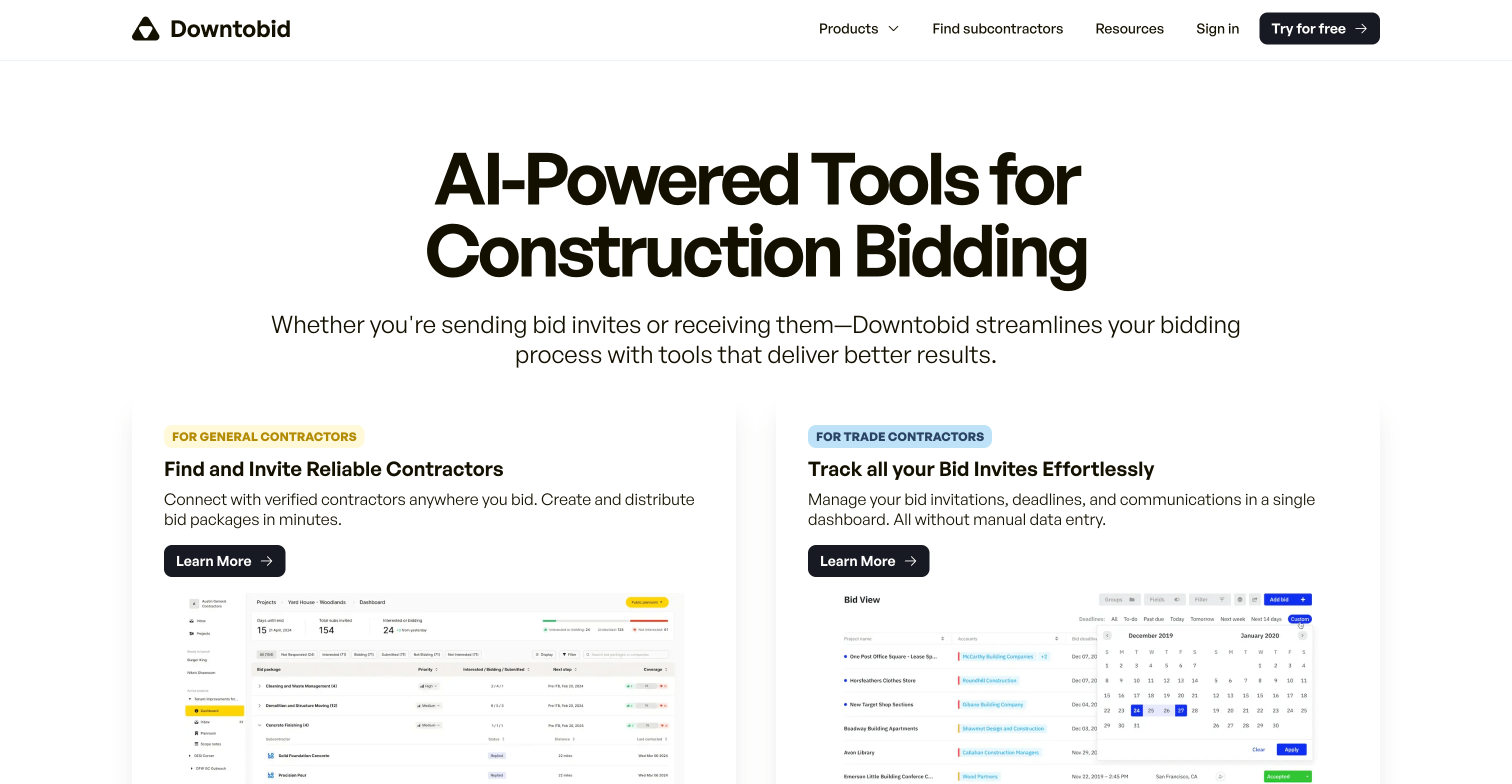
Downtobid is a modern construction bidding platform that focuses on automating and simplifying the ITB process for GCs while making it easier for subs to engage. Founded as a technology-driven alternative, Downtobid leverages AI to handle time-consuming bid management tasks – from analyzing plans to find needed trades, to matching those trades with qualified subs, to drafting personalized bid invitations
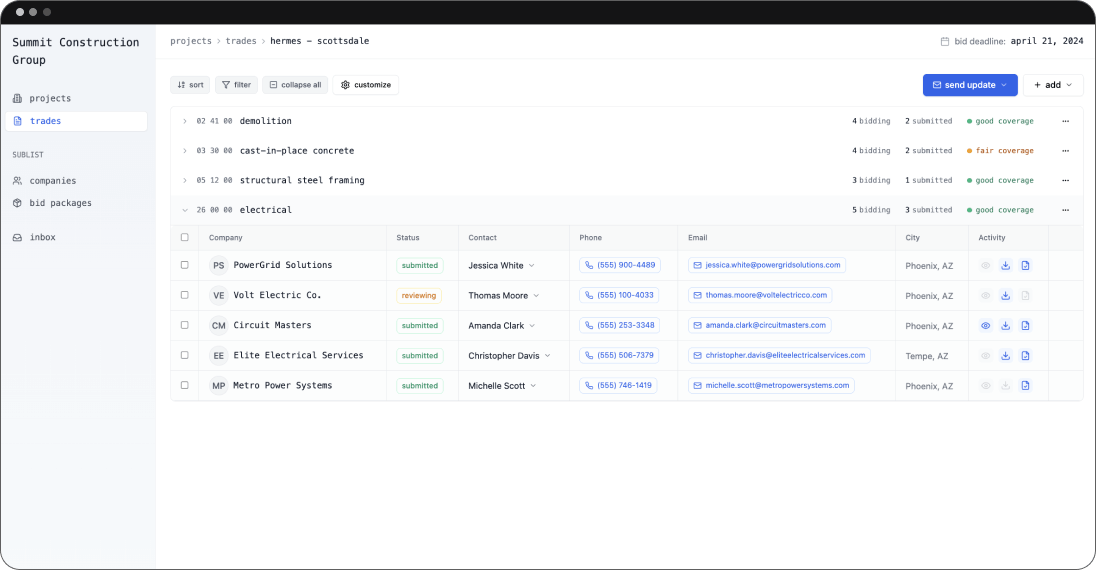
In Downtobid, a GC starts by uploading their project plans and specs. The platform’s AI then drafts a high level overview of the scopes of work/trades required and generates a tailored list of local subcontractors for each scope. This means GCs don’t have to manually comb through drawings for every trade – a process that can take hours per project – the software provides an initial scope breakdown automatically
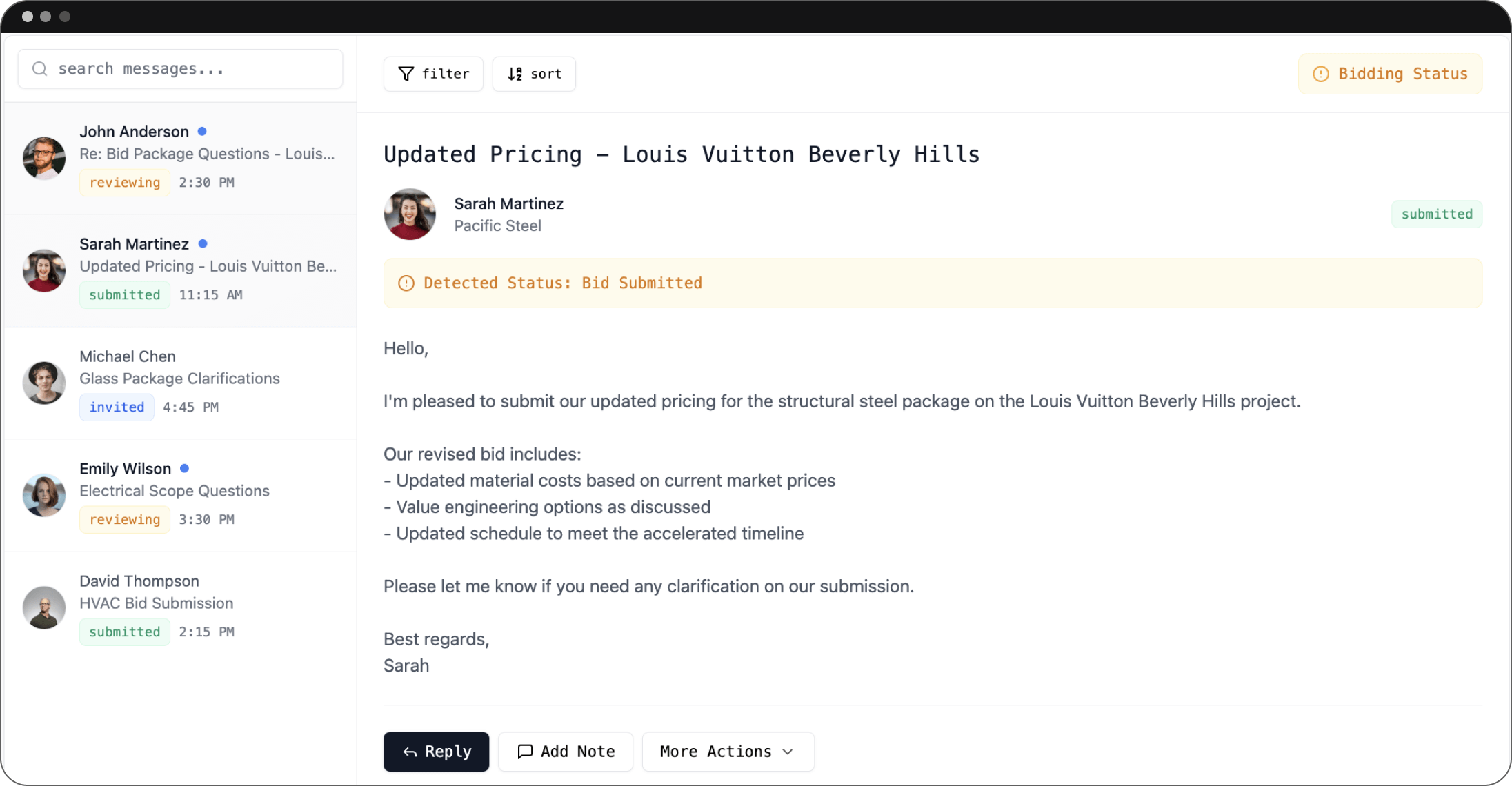
In summary, Downtobid’s approach is to streamline the GC’s workflow (through AI and automation) and boost sub participation (through personalized outreach and easy access).
What Is PlanHub?
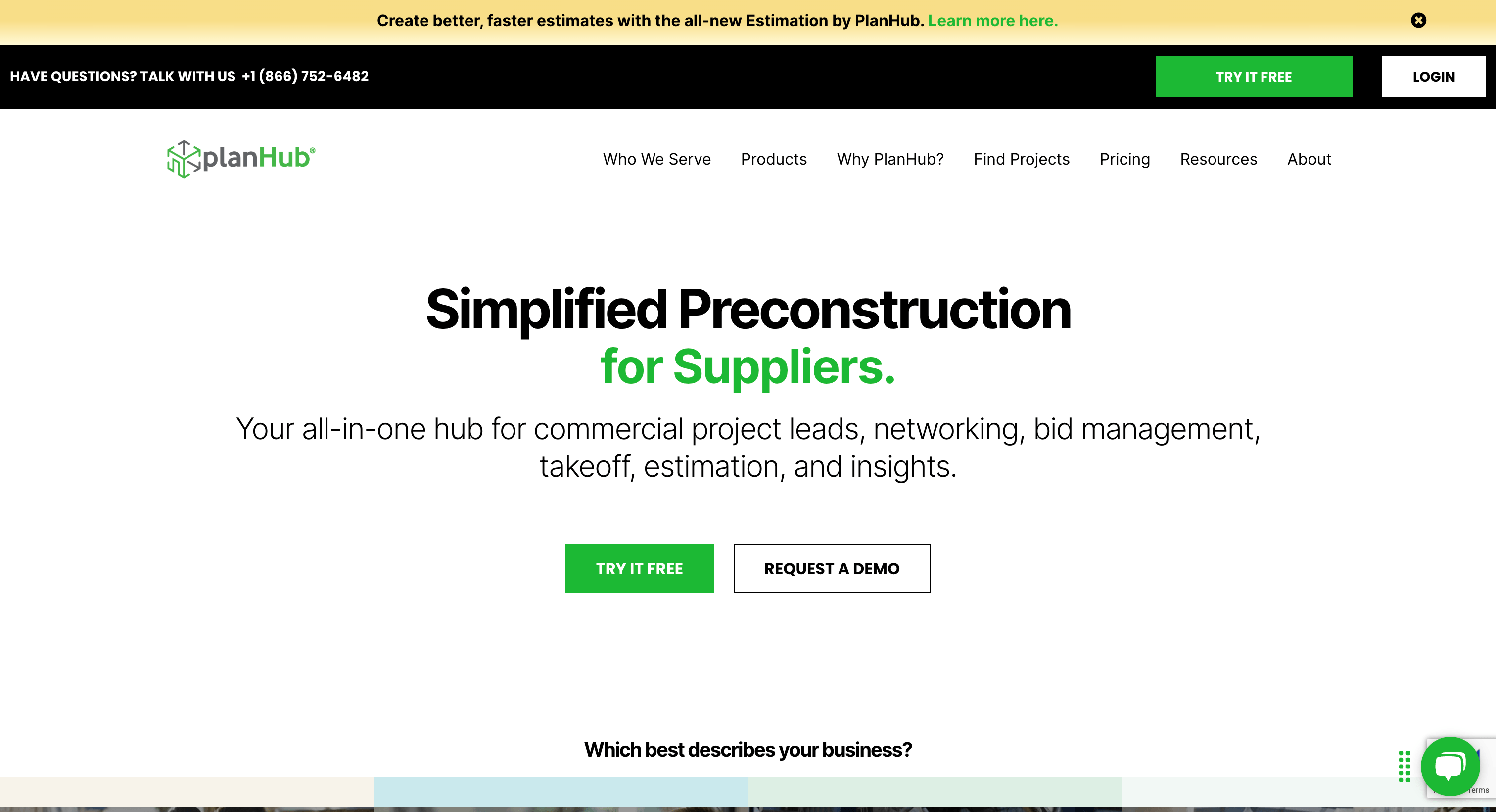
PlanHub is a construction bidding platform known for its wide reach. GCs can upload project documents into a digital planroom, share them with subcontractors, and see basic tracking of who has viewed or downloaded files. The platform offers multiple subscription tiers, granting more or less access to features and regions.
For GCs who want a bigger pool of potential bidders, PlanHub’s network might be appealing. However, some trades say they’re deterred by mandatory account setups or paywalls just to see details—especially when they already juggle invites from multiple sources. Still, many GCs appreciate having a single hub to post projects and possibly connect with new contractors. Click here for more of an overview.
Key Core Features Of Downtobid
Here are some of the best features the software offers.
AI Assisted ITB Drafts
The hallmark of Downtobid is automation. When you upload your plans, the system scans them to identify which trades are needed (not in extreme detail, but enough to highlight “You likely need electrical, plumbing, HVAC,” etc.). Then it suggests matchings from its verified database.
- Pros: Saves hours on scoping at a high level, so you don’t forget a key trade
- Cons: Some GCs prefer to do scoping manually; the AI might occasionally miss extremely specialized trades
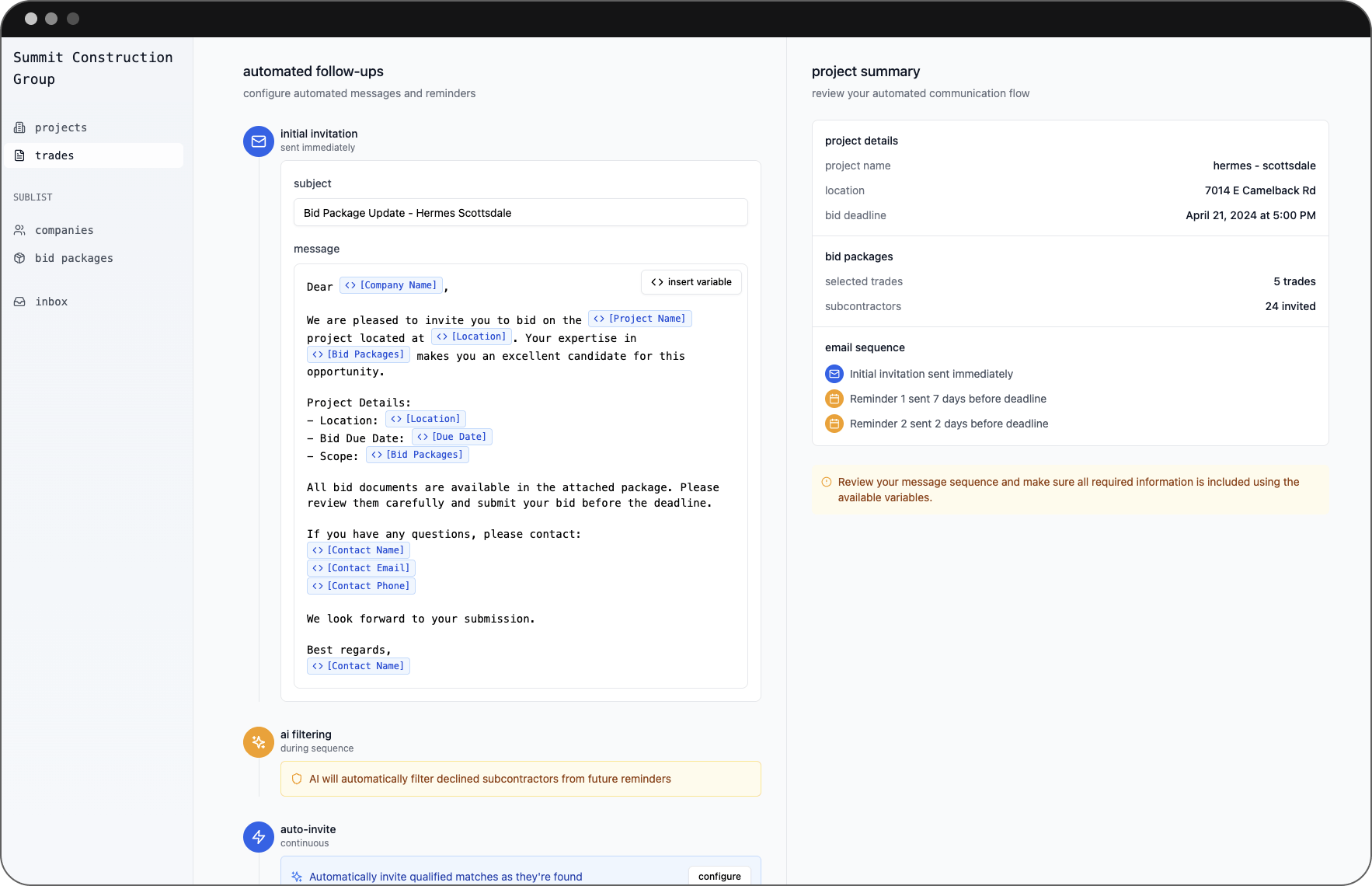
Verified Subcontractor Database
Downtobid’s database is smaller than ConstructConnect’s but focuses on quality. The platform verifies each contact, removing stale emails or defunct companies. For GCs, this means less time wasted sending invites to contacts who won’t respond.
- Pros: You’re reaching active, relevant subs more reliably
- Cons: Might not have the same breadth for rarely used or ultra-niche trades, so you may add those manually
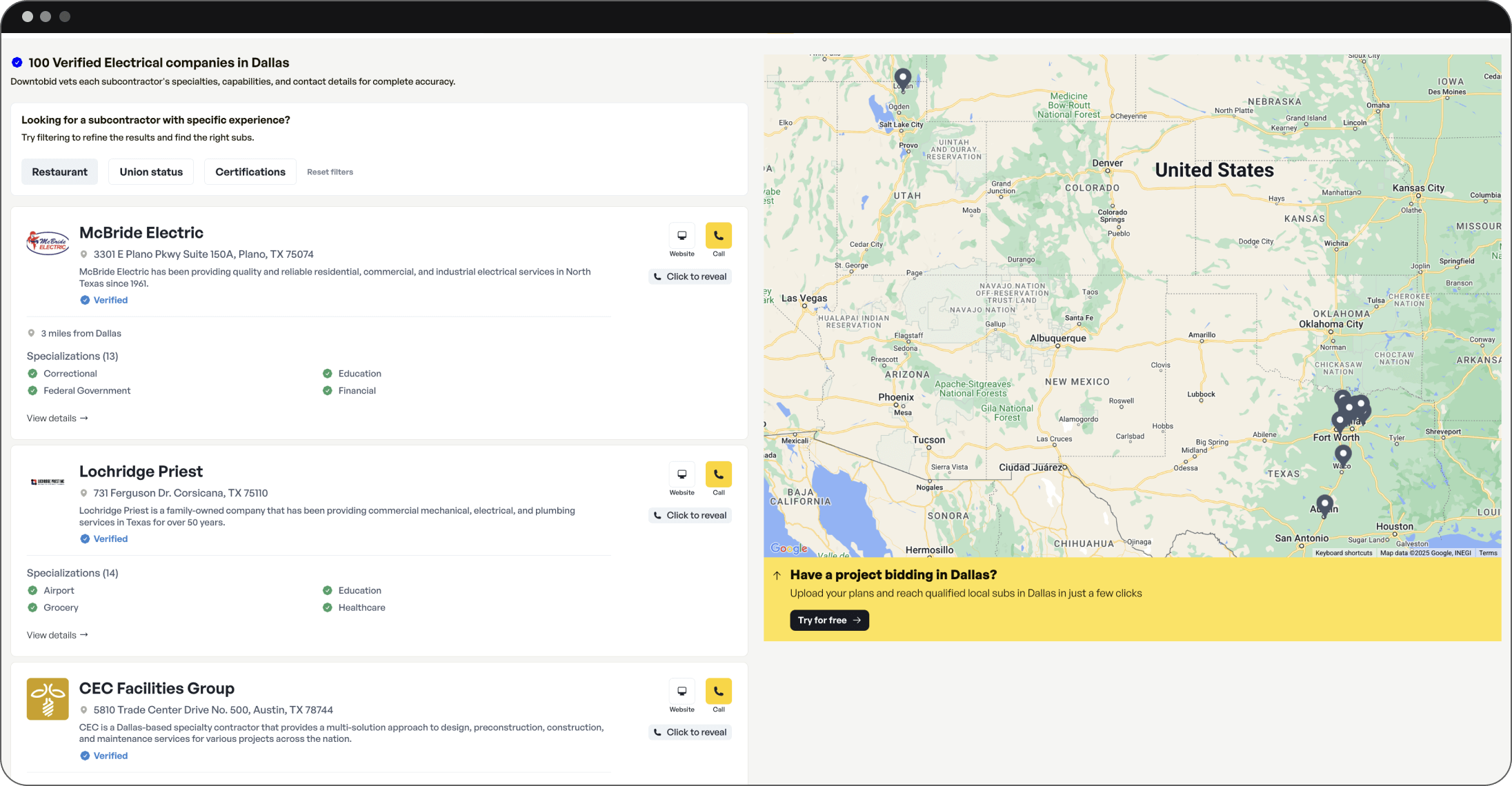
Sub-Friendly Planroom (No Logins)
Downtobid organizes the uploaded docs automatically (Plans, Specs, Photos, etc.) and indexes them so each page is labeled. Subcontractors can open the planroom without creating an account, which drastically reduces friction.
- Pros: Less hassle for subs, typically boosting engagement
- Cons: GCs wanting advanced permission controls might not find them
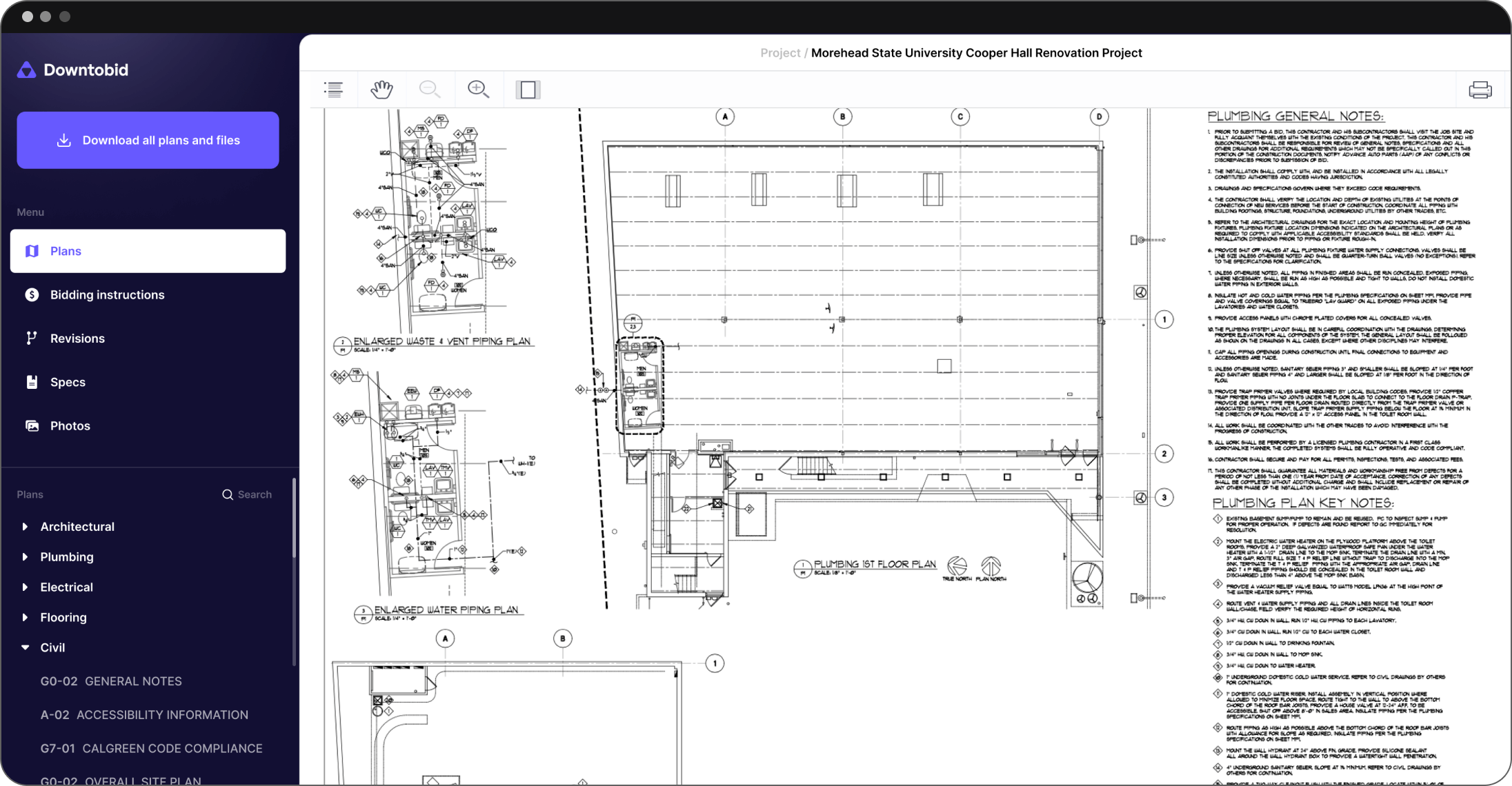
Automated Follow-ups & Real-Time Coverage
After sending invites, Downtobid watches who’s opened the email or downloaded files. If a sub hasn’t responded, the system sends polite reminder emails at intervals. GCs see a live coverage board showing “Bidding,” “Not Bidding,” or “No Response.”
- Pros: Freed from phone-tag with every sub; higher chance of timely replies
- Cons: Some GCs still want personal calls for key subs; advanced reporting might be limited compared to older enterprise tools
Integrations & Ongoing Development
Downtobid’s approach is to minimize external steps for bidding alone. It’s building out integrations with major PM tools. Because it’s newer, it might not yet have every integration that SmartBid does, but it updates frequently, driven by user feedback.
- Pros: AI plus integrated plan management = fewer apps needed
- Cons: If you rely on legacy software or highly specialized ERP, you might see fewer direct sync options
PlanHub’s Core Features
PlanHub has some key features that make the tool so popular in the construction industry. However, despite offering a wide network, has faced criticism for its accessibility issues and lack of transparency. It requires subcontractors to create accounts, pay for accessing and bidding on certain projects, and obscures essential information like general contractor contact details behind a paywall.
1) ITB Management
PlanHub acts as an online marketplace for bids. GCs create a project listing, upload plans/specs, and invite subcontractors by selecting relevant trades or a geographic region. The system then notifies every sub matching those criteria.
- Pros: GCs cast a wide net without paying anything. Potentially thousands of subs see your project.
- Cons: Invites are fairly generic. Subcontractors must log in (and often pay) to see details. GCs can’t deeply customize each invite’s content.
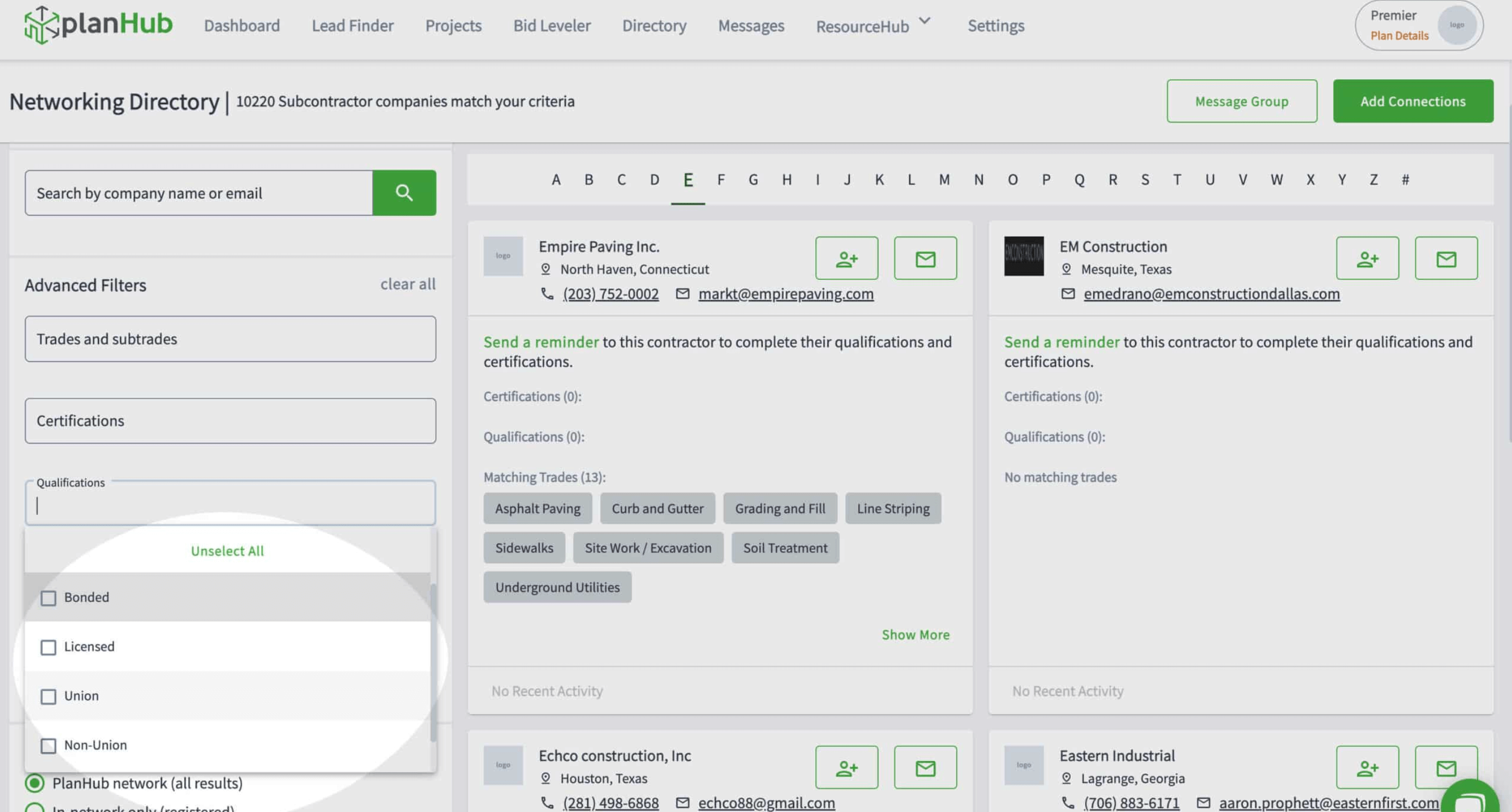
2) Large Network & Paywalls
PlanHub has grown its user base significantly, advertising thousands of GCs and subs. The big selling point: “Post your project for free!” for general contractors. But for subcontractors, there’s a tiered plan. Free sub accounts get minimal info (and can’t even see who posted certain jobs), while higher-tier subscribers get better visibility.
- Pros: GCs pay $0. Free exposure to a big sub pool.
- Cons: Many subs resent the forced sign-up or paywalls. Non-paying subs might skip or ignore invites, lowering real engagement.
3) Digital Planroom & Document Sharing
PlanHub lets you upload unlimited files for each project in a single planroom. Subs can log in, view or download docs, and you can see if they’ve accessed them. It’s straightforward but requires each sub to sign in, a common complaint.
- Pros: One place for document management to store drawings, specs, addenda.
- Cons: Force-logged in approach. If subs don’t want to sign up (or pay), they might bail.
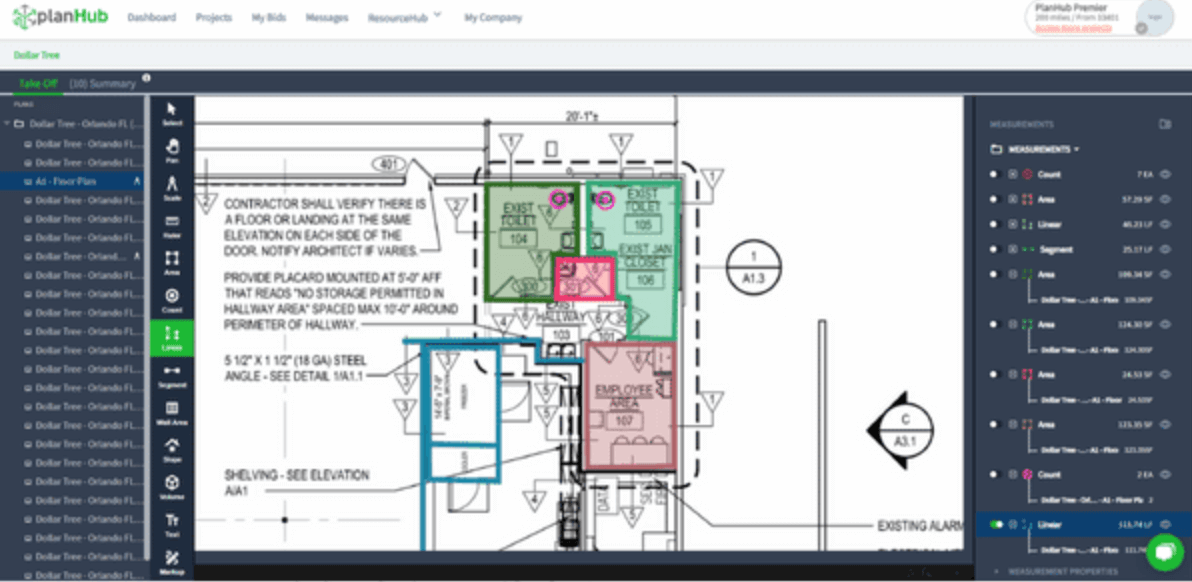
4) Basic Bid Activity Tracking
PlanHub shows which subs have viewed the project or downloaded documents. However, follow-ups beyond that are mostly on the GC. GCs can message subs through PlanHub, but it’s not heavily automated.
Pros: At least you see who’s looked at the files. Cons: No robust reminders if subs haven’t responded. Coverage can remain unclear until late.
5) Workflow Efficiency & Pricing
For GCs, PlanHub’s biggest draw is its no upfront cost. Everything else is overshadowed by the sub paywalls—subcontractors must pay for expanded features or to see GC details. Some GCs feel it’s a “free lunch,” but if your subs dislike or ignore the platform, that free lunch might come with hidden coverage costs.
- Pros: Zero direct cost for GCs.
- Cons: Sub friction can reduce actual bid responses, leading you to do more manual outreach.
PlanHub vs. Downtown: Features Compared
Below we examine how PlanHub and Downtobid stack up in several key areas of functionality. Each section declares a “winner” based on which platform offers the better experience for that category, followed by an explanation.
ITB Management
Winner: Downtobid – When it comes to creating and sending Invitations to Bid, Downtobid provides a more flexible and informative process for GCs and subs alike. PlanHub uses a one-size-fits-all approach: GCs upload their project details and PlanHub blasts out a generic ITB notification to every matching sub in its system (often thousands of them) without much customization.
GCs on PlanHub cannot tailor the invitation email to introduce their company or highlight project specifics – subs typically get a standard notice and must click through to PlanHub’s site to learn the project details. This lack of personalization can hurt engagement, as busy subcontractors might ignore an invite that feels like just another mass email. In contrast, Downtobid crafts personalized ITBs for each subcontractor.
The platform auto-includes key details in the email – such as the project type, location, and a brief scope of work – so the sub can immediately tell if the job is relevant to them.This level of detail up front means a sub doesn’t have to log into anything to gauge interest – they know right away what the project is and who it's from.
Subcontractor Network
Winner: Downtobid – Both platforms maintain large networks of subcontractors, but Downtobid emphasizes quality and relevance over sheer volume. PlanHub has been around longer and boasts a massive user base – when you post a job on PlanHub, it can notify on the order of 3,600 subcontractors per project on average in the relevant trades/region.
This wide casting of the net can help new GCs get exposure, but it often sends invites to subs who are not actually a good fit or not interested. In fact, many subs report getting flooded with PlanHub emails for jobs that don’t match their trade or are outside their area. So while PlanHub’s network is extensive, the signal-to-noise ratio for any given ITB can be low.
Downtobid takes a more curated approach. The platform has a database of tens of thousands of subcontractors, but it uses algorithms to pick out the ones most likely to fit your project. After its AI analyzes your plans and determines the needed scopes, Downtobid automatically recommends a tailored list of subs who work in those trades and in the project’s locale. In other words, it aims to invite only those subs who are qualified and active for that kind of job, instead of blasting every possible contact.
Planroom & Document Sharing
Winner: Downtobid – Sharing project plans and specs with bidders is essential, and Downtobid makes it especially easy for subs to access what they need. PlanHub functions as an online plan room where GCs can upload all their project files for subs to download. Both platforms allow unlimited documents and have features to organize files, but the user experience for document management differs greatly.
On PlanHub, because subs have to log into the portal, they often encounter a generic file repository. If the GC hasn’t structured the folders well, a sub might see a long list of files and have to download large PDFs just to find the pages relevant to their trade. This can be tedious. PlanHub does ensure that every project includes necessary drawings and specs, which is good, but it leaves the onus on subs to sift through them.
Moreover, a sub on a free account might not even get that far if they don’t want to go through the login/signup process to access the files.
Downtobid’s plan room is designed for instant, no-login access. When a sub clicks the project link in their invite email, the plan room opens immediately in their web browser with no account required. All project files are neatly sorted into standard folders (Plans, Specs, Photos, Misc) automatically, and Downtobid’s system auto-sheets and labels each page of the plans.
For example, drawings are indexed by sheet number and title, so a subcontractor can use a search or jump straight to the electrical plans, or the door schedule, etc., without downloading everything. This saves a lot of time, especially on big plan sets. Essentially, Downtobid mirrors the way an experienced estimator would organize a plan room, but it does it by default for every project.
Follow-Ups & Coverage Tracking
Winner: Downtobid – Getting subs to respond and tracking your bid coverage is an area where Downtobid outshines PlanHub through automation. On PlanHub, once invites are sent out, GCs can see some basic status info like which subs have indicated they are bidding, not bidding, or “undecided.” PlanHub includes a feature for subs to click an I’m Interested / Not Interested button on the invite, which is a common mechanism in bid platforms. However, in practice many subs don’t bother to respond to those prompts, leaving GCs with a lot of “undecided” and unknowns.
Downtobid was built to make follow-up less of a manual chore. First, it tracks engagement on each invite in real time – you can see if a subcontractor has opened the email, clicked the project link, and whether they’ve responded to indicate interest.
The platform then automatically sends follow-up emails to subs who haven’t responded after a set interval. These reminders are gentle prompts that keep your project on the sub’s radar without you having to pick up the phone 80 times. GCs can typically configure or rely on Downtobid’s default schedule (for example, a second notice a few days after the initial invite, and another one closer to the bid due date).
Pricing & Value
Winner: Downtobid – This category is a bit complex, because the cost structures of these platforms differ for GCs vs subs. On face value, PlanHub seems unbeatable on price for general contractors: it’s completely free for GCs to use, no matter how many projects you post.
Downtobid, by contrast, is a paid subscription for GCs (after a free trial project) – with plans that can run a few hundred dollars per month for full access. However, the true value of these platforms is tied to project outcomes and time savings, not just the sticker price. GCs must consider how the pricing model affects subcontractor participation and the efficiency of the bidding process.
With PlanHub, the catch is that while you pay $0, your subcontractors might be paying significant fees to fully utilize the platform. Many subs are reluctant to do so. The cost of PlanHub varies as they offer tailored pricing plans to suit the diverse needs of the construction industry, from local contractors to national enterprises. Depending on what your company needs, may help you decide if PlanHub is worth it.
A subcontractor would need to invest roughly $1,200–$3,300 per year for a PlanHub subscription if they want wide geographic coverage and the ability to see all project details.
Not all subs will justify that expense, especially smaller outfits. Those who don’t pay will have a limited experience (as discussed, they can’t see GC contact info or sometimes even which GC posted the job without upgrading). This can directly affect a GC’s results. If the best subs in your area ignore PlanHub invites because they don’t have a paid account, you could miss out on competitive bids.
Downtobid’s pricing, on the other hand, is directly paid by the GC, and subs pay nothing to receive or respond to invites. This flips the incentive structure: subs have no barrier to participating, which can translate to better coverage for you.
For example, a GC on Downtobid’s Starter plan at ~$150/month might send hundreds of invites in that time; none of those subs will be asked to pay or subscribe to reply. From the subs’ perspective, an invite through Downtobid is just like a personal email from the GC (with all info readily accessible), which encourages free and easy bidding. So while the GC has a budget line for bid software, the ROI comes in the form of higher response rate.
Planhub Vs Downtobid: What Reddit Users Are Saying
It’s always insightful to hear from contractors who have used these platforms in the field. On Reddit’s r/estimators and other construction forums, opinions about PlanHub and Downtobid have been candid. PlanHub in particular has drawn some ire from subcontractors. In one discussion, a user vented, “I can’t stand them. Usually when I get [PlanHub] invites I contact the GC directly. Their pricing is ridiculous.”
Another subcontractor said they’ve gone as far as blocking PlanHub emails due to the spam: “I have the word ‘planhub’ blocked in my email... I’ll have one or two a month sneak through and I block those addresses as well”.
The common theme among these complaints is frustration with the barrage of untargeted invites and the feeling that PlanHub is trying to monetize access. As one Redditor observed, _“they changed CEOs and now they’re trying to ‘make money’ off the tool. you cannot even see some GCs without paying.” _
From the GC side, some estimators also feel that platforms like PlanHub don’t solve the core problem of low sub responsiveness. One estimator shared that regardless of which invitation system you use, “you will likely need to follow up no matter what… we still have to call ~80% of subs to get concrete answers. Most of the time they haven’t even looked at the invite yet.” This was in context of PlanHub and similar tools – highlighting that simply sending out invites isn’t enough if the platform doesn’t actively engage subs.
On the flip side, Downtobid has started to garner positive word-of-mouth on Reddit as a newcomer. In the same thread above, the original poster came back with an update after trialing multiple platforms: "after tons of demos with BuildingConnected, trying PlanHub, iSqft, etc – they were all pretty much the same tool. I ended up going with a startup that I found called Downtobid. I’m a big believer…”
This user noted that Downtobid’s team is actively improving the product (even mentioning the founder participates in the community), which gave them confidence that it addresses the pain points where older software hasn’t.
While Downtobid is newer and thus has fewer online reviews, these early adopters on Reddit cite its focus on solving the follow-up problem and providing a modern interface as big pluses. It’s worth noting that many GCs in discussions mention using multiple tools – some keep PlanHub in their toolkit for the free exposure, but supplement it with more proactive solutions like Downtobid for critical projects.
As always, the Reddit perspective is just one source, but it underscores the real-world challenges GCs face (subs ignoring invites, etc.) and highlights that Downtobid’s approach is resonating with those who have tried it.
Choosing the Right Platform
Both PlanHub and Downtobid aim to make commercial bidding more efficient, but their philosophies differ:
- PlanHub leans on a large network and a standard planroom. This could be good if you’re looking to tap into new regions or want a single spot to post all your projects. However, some users find the subscription tiers and forced logins off-putting for subs.
- Downtobid targets proactive coverage, sub-friendly invites, and scaling without chaos—all under one automated system. You might not see the same massive network, but GCs who prefer quality over quantity (and who value automation) often find it a smoother experience.
Who Is Downtobid Made For?
For Commercial General Contractors:
Estimators leverage our AI to perform thorough page turns, making sure no major trade is overlooked and providing a concise summary. The AI Copilot then recommends optimal bid packages, aligning them with a vetted list of local subcontractors, and includes a detailed scope of work within each invitation to bid. This process minimizes scope gaps in the preconstruction phase, speeding up project planning and execution.
For Trade Contractors:
Our software empowers estimating teams to assess hundreds of opportunities simultaneously. The AI Copilot reviews each plan set or bid invite, identifying scopes relevant to your trade. Suitable projects are automatically populated onto a bid board/calendar, complete with all critical information (deadline, GC, etc.), enhancing project selection and bid strategy with comprehensive analytics for win/loss insights.
How To Use Downtobid To Speed Up The Bidding Process
The software handles your bidding process by automating the analysis and organization of project plans. Just upload your documents and our AI Copilot takes over, generating personalized bid invites within minutes.
AI-assisted Page Turns To Identify Key Scopes
The software leverages AI to automate the identifying of key scopes process. By replacing manual page reviews with AI-assisted technology, the tool makes sure you have a faster, more accurate bidding experience. This approach not only speeds up the process but also guarantees the completeness of every bid.
Bid Invites In Minutes
Upload documents and get personalized bid invites and scope sheets in minutes. The software automates the creation process, ensuring each invite is customized with contractors' names for a direct, engaging approach. In fact, users have reported a 30% increase in replies. This efficient system saves time and enhances bid accuracy, streamlining project kick-offs.
Central Planroom For Document Management & Collaboration
The central Planroom cuts through the clutter of bid invites, offering subcontractors a direct path to quickly find and search project scope. No accounts required, and with the tool's investment in fast loading times and mobile compatibility, qualifying bids has never been easier or more accessible to collaborate.
Final Thoughts
The days of easy, face-to-face bidding are largely behind us, but that doesn’t mean your bid process has to be a headache. PlanHub and Downtobid both try to streamline online invitations, albeit in different ways.
Ask yourself:
- Do I need sheer volume and exposure, or do I prefer accurate, real-time coverage with fewer manual follow-ups?
- Are my trade contractors okay with creating new accounts and navigating paywalls, or do they want a direct, hassle-free invite?
Whichever platform you choose, the goal is to restore clarity and trust to your bidding process. Both PlanHub and Downtobid can help. It’s just a matter of deciding which features—and which user experience—will keep your projects on track.
Obviously, we’re a bit biased—if you’re looking for a team that’s hands-on about updates and sub engagement, give Downtobid a look. Otherwise, explore PlanHub’s network and see if it’s right for you. The important thing is finding a tool that keeps your bids organized, your subs happy, and your team free to focus on winning projects.
(Sources: Discussions on Reddit: anyone use planhub? they blast me with emails : ( r/estimators) and user feedback in r/estimators (what bid invite software do you use? : r/estimators) (what bid invite software do you use? : r/estimators).)